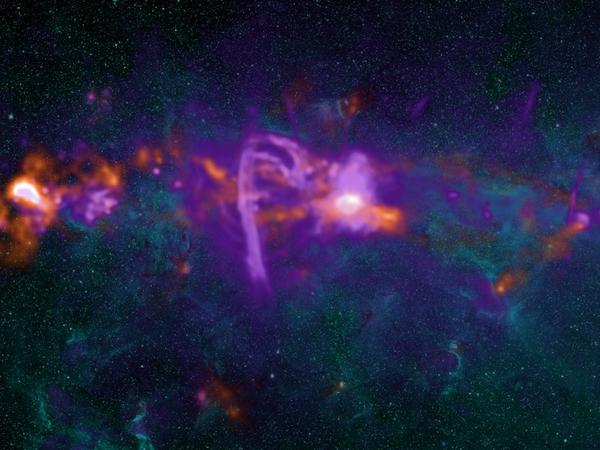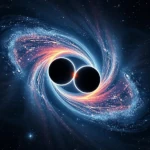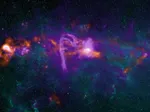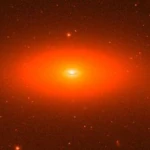Sagittarius A and the cloud of gas in 2013
Sagittarius A, our black hole in 2013
The Milky Way is the central region of our Galaxy. On the infrared image shows against the exact center of our galaxy, known as the Central Molecular Zone and purple arc radio galactic center. A number of emission nebulae are visible through the massive young stars that illuminate the interior. Like almost all galaxies, it contains in its center a black hole. This black hole of several million solar masses, is called Sagittarius A (Sgr A). It is located at 27000 light years from us. Our Sun is too far from the galactic center to be swallowed, and many other stars, objects or dust cloud will be before us. Especially those that revolve around the black hole in 16 years. Our sun orbits the galactic center at 230 million years.
Stefan Gillessen astronomers and Reinhard Genzel of the Max Planck Institute for Extraterrestrial Physics in Garching, Germany, and colleagues used the Very Large Telescope of the European Southern Observatory in Chile to observe the center of the Milky Way in infrared spotted a new object near the black hole. Astronomers have detected the object on the wavelength of 3.76 microns, indicating that it is a cloud of gas and dust, rather than a star, they say, because star would have been detected on a shorter wavelength of about 2.16 microns. The cloud is about three times more massive than Earth, emits five times more energy than the sun, and is 250 times the distance from Earth to the sun. Its temperature is about 550 Kelvin. The immense gravity of black hole Sgr A significantly accelerates the cloud. In 2004, the cloud rushed toward the black hole at 1200 km/s, in 2011, his speed was 2350 km/s. The cloud will plunge into Sagittarius A in summer of 2013, when he will be 260 times the Earth-Sun distance. Scientists will can observe this event for over a decade, see the cloud stretching and heat up to temperatures of millions of degrees.
It is probable once into the black hole, that the cloud emits X-rays Andrea Ghez astronomer at the University of California, Los Angeles, who saw the same object in her data, has another interpretation more likely, it would be a star, noting that the dust surrounding a star can absorb visible light and re-emit in the infrared. If the object is a star, it will not fall into the black hole, but it will pass around Sagittarius A every 140 years. We will explain in a few months before summer 2013.
Black holes are massive objects whose gravitational field is so intense that it prevents any form of matter or radiation to escape.
Black holes are described by the theory of general relativity. When the heart of the dead star is too massive to be a neutron star, it shrinks inexorably to form this mysterious astronomical object, which is the black hole. The stellar black holes have a mass of a few solar masses to billions of solar masses. They arise as a result of the gravitational collapse of massive stars residue.
A man already predicted in the 18th century, the existence of dark stars, physicist, astronomer and British geologist John Michell (1724-1793). In his notes he writes that when a star becomes too massive, it attracts light under the influence of the gravitational force. However, as the calculations give a density of the star corresponding to 18 billion tons in cm3, he concludes that it can not exist. Today, the theory of black holes, stipulates that are objects so dense that its escape velocity exceeds the speed of light. Light can not overcome the gravitational surface and remain trapped. The theory also defines precisely the intensity of the gravitational field of a black hole. It is such that no particle crossing its horizon, boundary theory, can not escape.

 Gravitational Waves: Vibrations in the Cosmic Fabric
Gravitational Waves: Vibrations in the Cosmic Fabric  Primordial Black Holes: The Invisible Vestiges of the Young Universe
Primordial Black Holes: The Invisible Vestiges of the Young Universe  The curvature of time, a non-intuitive concept!
The curvature of time, a non-intuitive concept!
 Sagittarius A: Cosmic Monster Lurking at the Center of Our Galaxy
Sagittarius A: Cosmic Monster Lurking at the Center of Our Galaxy
 On the trail of invisible black holes: gravitational impact and effects on nearby stars
On the trail of invisible black holes: gravitational impact and effects on nearby stars
 The Monster of NGC 1277: A Black Hole That Defies Theories
The Monster of NGC 1277: A Black Hole That Defies Theories
 Central area of the Milky Way
Central area of the Milky Way
 The first image of a black hole
The first image of a black hole